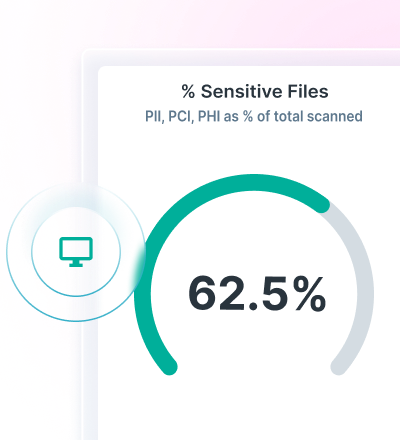Top 5 Data Risks of Using Microsoft Copilot
0 minutes de lecture

Neeraj Nayak
Copilot is revolutionizing productivity by synthesizing enterprise knowledge on demand. Yet the same capabilities amplify unseen cybersecurity risks, and become a gateway for data leakage, compliance violations, and operational blind spots. For cyber security leaders, understanding these risks is the first step toward safely enabling the adoption of AI.
Leading Microsoft Copilot risks
Uncontrolled exposure of confidential files
Copilot respects existing permissions. But its ability to reference enterprise files means overshared or misconfigured Microsoft OneDrive and SharePoint permissions can surface highly sensitive documents to unintended users. One misconfigured file or folder can lead to enterprise-wide data exposure. This risk is amplified by incorrect or inconsistent data classification. When sensitivity labels are missing, misapplied, or fail to cover all file types, Copilot may treat confidential content as non-sensitive, increasing the likelihood of accidental exposure.
Data leakage through prompts
Traditional security tools weren’t built for AI-driven interactions. Most organizations cannot see what prompts users enter into Copilot, what responses Copilot generates, or where that content flows next. This lack of visibility creates blind spots across the AI workflow.
Insider misuse
GenAI can accelerate both productivity and misuse. Malicious insiders or careless employees can exploit Copilot to access sensitive data they shouldn’t see, or intentionally feed confidential information into prompts, creating a new vector for data exfiltration. Independent research shows insider incidents are persistent, costly, and largely negligent in origin; Ponemon’s global benchmark found 55% of insider incidents stem from negligence, underscoring the need for access hygiene and user‑risk controls.
Shadow AI and agent sprawl
Employees are not waiting for policy. They often experiment with unapproved AI plug-ins, connectors, and third-party agents. Each one expands the attack surface and introduces data leakage risks outside your Microsoft 365 tenant. Microsoft’s 2024 Work Trend Index found 75% of knowledge workers use AI at work and 78% bring their own AI (BYOAI).
Compliance violations
Regulated industries face strict audit and retention requirements. Without visibility into AI interactions, organizations struggle to prove who accessed what data and when, leading to compliance gaps.
Building Guardrails for Responsible AI Adoption
The good news: these risks are manageable with the right governance and security controls. Organizations can accelerate AI adoption without compromising trust, compliance, or productivity by implementing a layered approach that blends visibility, context awareness, precision protection, and continuous response.
Here’s how it works:
See Everything
Start with complete visibility into AI interactions across your environment.
- Monitor prompts, responses, and file attachments to understand how AI systems are being used.
- Provide actionable insights through dashboards that highlight AI data flows, usage patterns, and granular activity logs.
- Eliminate blind spots and establish a foundation for governance.
Understand Context
Reduce noise and improve accuracy with AI-powered intelligence.
- Classify sensitive data accurately within AI platforms and the applications they interact with.
- Map models to data sources, prompts, and outputs to track exposure.
- Apply adaptive controls that scale dynamically based on user behavior and data sensitivity, without slowing productivity.
Protect with Precision
- Deliver protection without compromise.
- Inspect prompts and outputs in real time to prevent confidential data leaks (e.g., PII, financial records, source code).
- Enforce access boundaries automatically, revoking permissions before AI assistants expose data, reducing insider misuse and strengthening compliance posture.
Respond Continuously
- Enable proactive, automated remediation
- Trigger automated remediation actions when policy violations occur.
- Monitor for shadow AI tools and plug-ins, blocking unauthorized usage and coaching users toward sanctioned solutions.
- Maintain audit-ready compliance reporting for regulated industries.
Streamline investigations with incident workflows, prioritized alerts and unified policy management.
Forcepoint’s integrated platform combines Forcepoint CASB, Forcepoint DLP, Forcepoint DSPM, Forcepoint SWG, and Risk-Adaptive Protection to secure AI interactions and ensure their data is AI-ready. This enables organizations to accelerate their AI deployments, while safeguarding sensitive data, maintaining compliance, and reducing risk.
Want to learn how Forcepoint secures Microsoft Copilot?
AI is here to stay, and Microsoft Copilot is leading the charge. The question isn’t whether to adopt. It’s how to do it securely. Forcepoint is leading the charge on securing Copilot adoption through an AI-native approach that combines API-based visibility with inline enforcement.
View our recent webinar on-demand:
CISO Guide to Securing Copilot and the Future of Work
Learn practical strategies, see real-world demos, and discover how to enable Microsoft Copilot without compromising security or compliance.

Neeraj Nayak
Lire plus d'articles de Neeraj NayakNeeraj Nayak is a Senior Product Marketing Manager at Forcepoint. With over a decade of experience in the cybersecurity industry, Neeraj has a deep understanding of cybersecurity solutions including SASE, SSE, CASB, ZTNA, DLP, and SD-WAN. Neeraj previously held product marketing roles at Netskope, Skyhigh Security and Lookout. Neeraj holds an MBA degree from IIM Mumbai and an Engineering degree from NIT Warangal.
- Microsoft 365 Data Security Playbook
Dans l'article
 Microsoft 365 Data Security PlaybookLire le Livre Électronique
Microsoft 365 Data Security PlaybookLire le Livre Électronique
X-Labs
Recevez les dernières informations, connaissances et analyses dans votre messagerie

Droit au But
Cybersécurité
Un podcast couvrant les dernières tendances et sujets dans le monde de la cybersécurité
Écouter Maintenant








